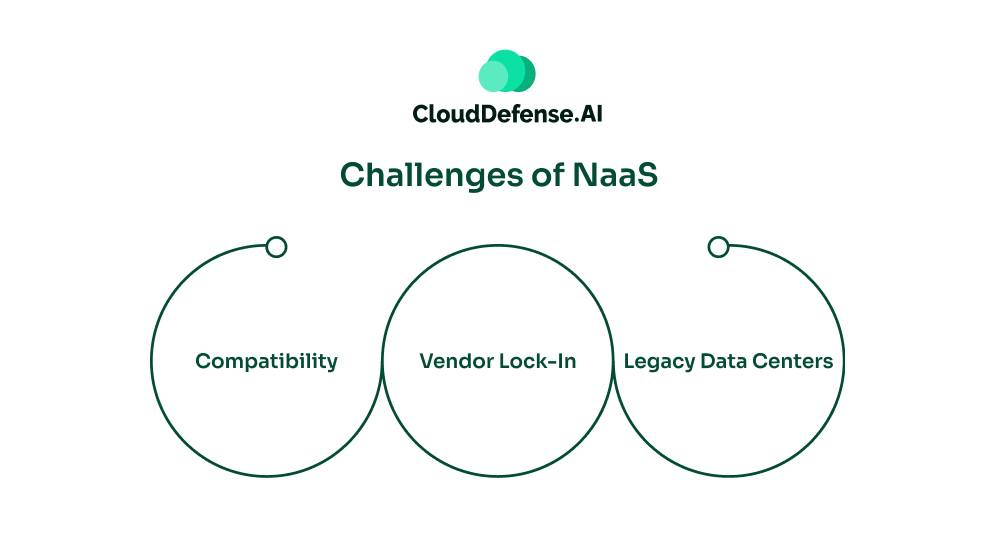What is NaaS (Network-as-a-Service)?
Network-as-a-Service, or NaaS, is a cloud service model where customers lease networking services from providers, eliminating the need for physical networking infrastructure. This allows businesses to create and manage their own networks using software over the internet.
This replaces traditional VPNs, MPLS connections, and on-premise networking hardware like firewalls and load balancers. NaaS simplifies enterprise networking by routing traffic and applying security policies through a cloud-based approach.
How does Network-as-a-Service work?
NaaS operates by providing organizations with networking services on a subscription basis, eliminating the need for purchasing, installing, and maintaining their own networking hardware. Customers access the provider’s network resources and choose from different options:
- Rented Hardware: The provider owns the networking hardware and rents it to customers, who are responsible for installation and operation.
- Managed Services: Customers use hardware on a subscription basis, while the provider handles its operation and maintenance.
- Full NaaS: The provider manages all aspects of the networking hardware, including installation, operation, and maintenance.
This model allows businesses to use networking services without the complexities and costs of traditional network infrastructure.
How did NaaS Develop?
NaaS developed as a response to the inefficiencies and complexities of traditional network infrastructures. Initially, enterprises built their own private networks and configured WANs using rented links and methods like MPLS.
Each office required its own hardware for firewalls, DDoS protection, and load balancing, and employees accessed the internet via corporate VPNs, creating bottlenecks and inefficiencies, especially as cloud adoption grew.
As business activities moved to the cloud, maintaining internal networks became impractical. Cloud computing advanced, enabling essential networking functions like DDoS mitigation, firewalls, and load balancing to be managed in the cloud. This shift reduced the need for internal IT teams to handle these tasks.
NaaS emerged as a more efficient solution, allowing companies to lease networking services from external vendors. This model eliminates the need for physical hardware and internal maintenance.
Employees can directly connect to the internet and access cloud services, with the NaaS provider managing security and traffic routing. NaaS represents the evolution of business processes migrating to the cloud, providing complete network services as an external, managed solution.
Challenges of NaaS

NaaS presents several challenges. We have discussed about three significant challenges below, that include compatibility, legacy data centers, and vendor lock-in.
Compatibility
Integrating NaaS with existing legacy systems can be problematic. Older components may not be compatible with the new NaaS infrastructure, requiring the replacement of some parts to ensure seamless operation and communication within the network.
Vendor Lock-In
Relying on a single NaaS provider can lead to vendor lock-in, where a business becomes dependent on the unique features and services of that provider. This dependency can create difficulties if the company wishes to switch providers due to dissatisfaction, as migrating to a new provider may require significant adjustments and potentially disrupt business operations.
Legacy Data Centers
On-premise legacy data centers may struggle to integrate with a cloud-based NaaS model. While there are intermediary cloud services available that can bridge the gap by transferring on-premise data to the cloud and then to the NaaS network, this additional layer can complicate the transition and may not always provide a perfect solution.
Advantages of NaaS

NaaS offers a range of benefits that make it an attractive option for modern enterprises. By using cloud-based networking solutions, businesses can enjoy cost savings, enhanced flexibility, and improved scalability. Here are some of the key advantages of adopting NaaS for your organization’s networking needs.
1. Cost Savings
One of the most significant advantages of NaaS is the potential for cost savings. By purchasing cloud services instead of building and maintaining their own networking infrastructure, companies can avoid the high costs associated with hardware procurement and maintenance. Vendors already have the necessary servers and infrastructure, allowing businesses to use these resources more economically.
2. No Maintenance
With NaaS, the cloud provider is responsible for maintaining the network, including managing software and hardware upgrades. This relieves internal IT teams from the burden of routine maintenance tasks, enabling them to focus on other strategic initiatives.
3. Flexibility
NaaS offers greater flexibility and customization compared to traditional networking solutions. Changes to the network are made via software rather than hardware, allowing IT teams to reconfigure corporate networks on demand to meet evolving business needs.
4. Scalability
NaaS is inherently more scalable than hardware-based services. Enterprises can easily increase their network capacity by purchasing additional resources from the vendor, eliminating the need to acquire, install, and activate new hardware.
5. Bundled with Security
NaaS providers often offer integrated security services, such as firewalls, along with networking services. This integration ensures tighter coordination between network operations and security measures, enhancing overall network protection.
6. Access from Anywhere
Depending on the configuration, cloud-based networks can be accessed from anywhere and on any device without the need for a VPN. This enhances mobility and flexibility for users, though it requires effective access control measures to ensure security.
How does NaaS relate to SASE?
NaaS and SASE are complementary technologies that enhance network performance and security. SASE is designed to secure individual applications regardless of where they are accessed, making it an ideal fit for the flexible and distributed nature of NaaS infrastructures.
By integrating SASE with NaaS, businesses can strategically deploy SASE units, or points of presence, throughout their NaaS-provided network. This allows organizations to secure specific applications effectively without compromising performance.
The NaaS provider can tailor the security measures for each application, ensuring that the highest levels of security are maintained while optimizing network efficiency.
IaaS vs NaaS vs PaaS
NaaS differs significantly from IaaS and PaaS. NaaS focuses exclusively on providing networking services, allowing businesses to manage networks without physical infrastructure. In contrast, IaaS offers virtualized computing resources, including servers and storage, while PaaS provides a platform for developing, running, and managing applications. Unlike IaaS and PaaS, NaaS does not include business software or data storage, concentrating solely on network functionality and optimization.
Final Words
The future of NaaS looks promising due to its flexibility and convenience. A Forrester report indicates that nearly two-thirds of IT leaders are transitioning to NaaS and other as-a-Service models. Just as SaaS revolutionized business applications in the cloud, NaaS is set to transform networking functions. By adopting NaaS, businesses can simplify network management, enhance scalability, and reduce costs, positioning themselves for success in the digital space.







